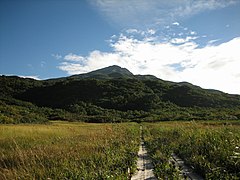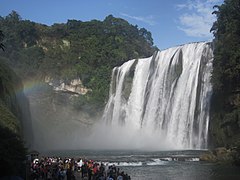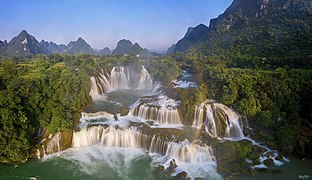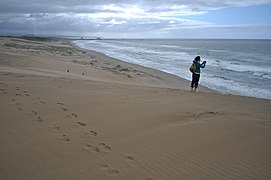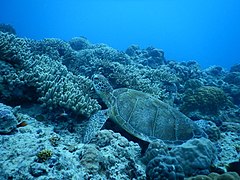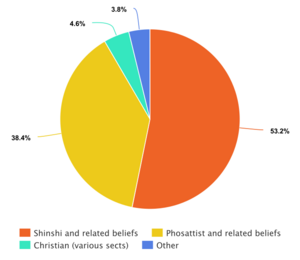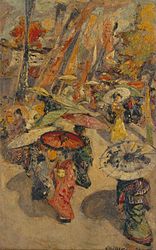Esonice: Difference between revisions
No edit summary |
No edit summary |
||
| Line 436: | Line 436: | ||
===Mythology and Folklore=== | ===Mythology and Folklore=== | ||
TBA | |||
===Festivals and holidays=== | ===Festivals and holidays=== | ||
| Line 448: | Line 448: | ||
===Cuisine=== | ===Cuisine=== | ||
TBA | |||
===Fashion=== | ===Fashion=== | ||
{{multiple image | |||
| align = right | |||
| total_width = 350 | |||
| image_style = border:none; | |||
| image1 = Example image.svg | |||
| alt1 = | |||
| caption1 = --- | |||
| image2 = In Paw Kone, seda de loto 1.jpg | |||
| alt2 = | |||
| caption2 = Lotus stem fibers being woven into a {{wp|lotus silk|vasuginu}} (lotus silk) thread. | |||
| direction = | |||
}} | |||
TBA | TBA | ||
===Music=== | ===Music=== | ||
TBA | |||
===Media=== | ===Media=== | ||
Revision as of 00:57, 13 June 2023
This article is incomplete because it is pending further input from participants, or it is a work-in-progress by one author. Please comment on this article's talk page to share your input, comments and questions. Note: To contribute to this article, you may need to seek help from the author(s) of this page. |
Serene Kingdom of Esonice Esonya 光国 | |
|---|---|
Anthem: "Land of a Thousand Flowers" | |
| Capital and largest city | |
| Official languages | Esonian |
| Recognised national languages | Esonian |
| Recognised regional languages | Various dialects |
| Religion | Secular |
| Demonym(s) | Esonian |
| Government | Federal parliamentary constitutional monarchy |
• Serene king | Shōkin |
• Prime Minister | Gimiko |
| Legislature | TBA |
| House of the lords | |
| House of the Commons | |
| Establishment | |
| 8th-9th centuries | |
| 16th century | |
| May 2nd 1912 | |
| Feb 11th 1940 | |
| Area | |
• | 354,835 km2 (137,003 sq mi) |
• Water (%) | 4.19 |
| Population | |
• 2022 estimate | 34,708,538 |
• Density | 95/km2 (246.0/sq mi) |
| GDP (PPP) | 2020 estimate |
• Total | $1.427 trillion |
• Per capita | $42,289 |
| GDP (nominal) | 2022 estimate |
• Total | $1.270 trillion |
• Per capita | $38,312 (10th) |
| Gini (2020) | 33.6 medium |
| HDI (2022) | very high |
| Currency | Esonian Zō (Ƶ) (ESO) |
| Time zone | UTC-8 |
| Date format | dd/mm/yy |
| Driving side | left |
| Calling code | +66 |
| Internet TLD | .es |
Esonice (Esonian: 光国, Esonya), officially the Serene Kingdom of Esonice is an island country located in the northern part of the Shield Island Chain in West Alharu and West Aurelia. The main island making up the majority of Esonice’s landmass is the island of Shinchō (Esonian: 心州), known for its heart shape appearance, the two other major islands being the smaller islands of Mibijima (Esonian: 竹島) and Hakaoshima (Esonian: 狖島). Surrounded by North Oriental Ocean to the west and the Gulf of — to the east. Esonice does not have any immediate borders except the port cities of Sademi and Mikura administered by Florentia, Yedo by the United Federation of Garindina and Maimi administered by the Kingdom of Seylos. It’s closest maritime neighbours are the state of Giokto, the Commonwealth of Andalla and the mainland of the Confederate States of Florentia. Consisting of various islands, Esonice covers a size approximately of 354,835km2 with a population density of less than 100 people per square kilometre. Maimedo (Esonian: 橙水) is the nation’s capital, it's also the most populous city with Marusonya (Esonian: 丸口) taking second place.
Esonice is classified as a high income developed nation, home to a population of 34,708,538 inhabitants. Following after its turbulent years during the 19th and early 20th centuries, Esonice enjoyed an economic boom which lasted from the 1960s to the 1990s. Today Esonian citizens enjoy a high standard of living, alongside a free universal healthcare system, high standards of education, and economic freedom. Esonice has a vibrant cultural heritage, spanning from Esonice's artistic scene, literature, music and popular culture in media, also having a strong animation and gaming scene. Esonice is especially known for its culinary prowess and deep mythology.
Internationally Esonice is a member state of the Aurelian League, Argic-Thalassan-Alharun Regional Association, Eurth Group of 7, Group of Island Nations, and an observer to the League of Alharu and Aurelian Native Nations. Esonice is also a permanent member of the Assembled Nations Security Council.
Etymology
TBA
History
TBA
Geography
TBA
TBA
- Top 8 locations in Esonice by province
Hakamora volcano in the Hakamora nature reserve in Kinchō. The volcano is located in the Hakamora caldera, the largest of it's kind and is the largest volcano in the country.
Lake Gamari is Esonice's largest lake and largest fresh water lake in Esonice located in Kinkai. It's considered sacred waters in Esonian folklore
Nujimoto falls is a known tourist hotspot in Hirumi due it's beauty and the various local legends surrounding it and the cave behind the waterfall. Not far from Nujimoto is Nujimoto castle, a royal residence belonging to the Serene Monarchy.
Wakagawa falls in Jubara surrounded by karst hills. In local folklore it was believed that drinking water from the waterfall at certain times of the year could help you maintain youth, it's also the widest waterfall in the country.
Dragon's Canyon in Honchō, named after the many dragon blood trees that grow there
--- in Sankai is the highest peak in Esonice. It's one of the few places in Shinchō that has occassional snow.
The steep Chugai cliffs in Echō province, voted to be the most picturesque landscape in Esonice by Esonians in national polls.
Climate and weather
TBA
Biodiversity
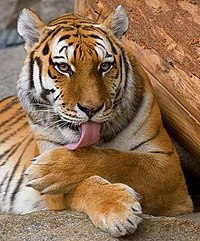
TBA
Rapid urbanisation and industralisation during the course of the 20th century alongside poaching by both foreigners and Esonian nationals took a toll on the Esonian enviornment, setting Esonice on course for desertification, deforestation and biodiversity loss with the prediction that by 2050 Esonice would lose a potential 30% of its biodiversity with droughts becoming commonplace according to a 1972 study. Government Programs have been put in place to prevent further damage to the enviornment, converting many vital areas of wildlife into nature reserves and national parks starting from the 70s. The government placed heavy consequences on illegal activities such as poaching and started putting restrictions and limits in areas such as fishing to prevent overfishing and damage to coral reefs. Various programs have also been started by non-governmental and religious groups to further protect endangered domestic species and habitats.
- Esonian fauna and flora
The Yellow hibiscus is the national flower of Esonice, it represents good fortune, joy, stability and longevity
The dragon blood tree is found in the arid regions of Honchō, the tree has many traditional and modern uses in medicine, makeup, dyes and rituals. The tree was sought after throughout history.
The Esonian white-cheeked gibbon inhabts many subtropical evergreen forests of Esonice. It's known as the Maruwū monkey (丸頬) in Esonice, meaning "round cheeked"
The Lesser flamingo can be found in parts of Honchō and northern Kinchō around alkaline lakes
Politics
TBA
Administrative divisions
TBA
Foreign Relations
TBA
Law
TBA
Military
TBA
Economy
WIP
WIP
High tech manufacturing
WIP
WIP
Tourism
Since the 1980s tourism has slowly become a significant sector within the Esonian economy, with further support from the government advertising Esonice to the international community through tourism campaigns starting in the 1990s. Popularisation of Esonian culture through products and media also had a very significant impact in attracting both foreign tourists and investment, and also helping Esonice's rapidly growing service sector.
Types of tourism varies, but the most popular form of tourism in Esonice is cultural tourism with there being a noticeable increase of international arrivals to Esonice during national holidays, events and festivals. The most visited city is Maimedo, the nation’s capital and well known for its big and very competitive street food scene. The Orange Palace, royal residence of the serene monarchy in the city, sees the most visits from tourists than any other historic landmark in Esonice with the palace being open to the public for most of the year. The other popular cities after Maimedo are Marusonya, Sushu Sadeki and Kado. Marusonya and Sadeki being popular cities for sightseeing of their historical monuments, museums, art galleries and historic old towns. While Kado and Sushu being popular for shopping, variety of recreational activities and their strong youth cultures. Sushu is known as a popular sports destination due to its annually held surfing competitions. Despite being restricted area due to ongoing tensions between Esonice and Florentia over the disputed territories of Sademi and Mikura, the wall separating Sademi from the rest of Esonice has become a relative point of interest for more risky tourists because of the art done by local artists through the decades and its history.
Due to Esonice’s environmental diversity and close state protection and preservation of natural areas, ecotourism and wildlife tourism have also become popular forms of tourism to the nation. International arrivals partake in outdoor activities such as hiking and climbing in the Central Shinchō Mountains, visiting natural landmarks such as Dragon’s Canyon and Nujimoto falls, cruising such as river cruising, sailing and observing local wildlife. Agritourism has also seen an increase in popularity in the past decades.
Seeing an opportunity to help struggling rural communities, The government has used tourism as an answer to many small towns and villages in the countryside endangered to abandoment due to younger inhabitants leaving to larger more economically developed cities. Wanting to encourage young people to stay and improve local economies, the government started a program funding rural communities and helping advertise them as tourist destinations. Since 2004 this has led to a revival of many towns, most notable examples being the historic villages of Hatani in Honchō and Ūgasai in Sankai where considerable growth in quality of life and wealth was observed including the villages quickly growing local service sectors which further led into development of their respective communities including building of schools and clinics. Many young people moved back in now that there were plentiful jobs, including new families which saved Hatani and Ūgasai from near total abandonment before the 2000s. This formula has also been applied to already abandoned villages. Miji, a once bustling hilltop village in Sankai and depicted by Iverican impressionist artist Solomon Simeon in the 1880s was left completely abandoned by its inhabitants after the death of its last resident in 1982. However in 2009, the Sankai provencial government with the help of the descendants of Miji families promised to revive the village as part of its revival agenda. Miji has seen massive success with the now revived village becoming a popular hiking and art destination. The revival program hasn't however gone without criticism. Critics of the program including some locals have claimed that this has led to the gentrification of the Esonian countryside with rural communities both losing their charm and identities. Allegations have also been ledged against the Esonian government of intending to purge local differences in national and cultural centralisation agendas.
Science and technology
WIP
Agriculture and fishery
WIP
WIP
Mining

Esonice has a thousands of years long and rich history of mining, going as far back as the 13th century BC. It historically has been one of the major sources of wealth for Esonice, in particular gem mining because of the abundance of precious and semi-precious stones - including large deposits of gold and silver thanks to the archipelago’s extensive volcanic history. Once a major sector within Esonian helping fund the country’s Industrialisation efforts in the early to mid 20th century, mining today has become a much smaller operation within the economy. A shadow of its former self threatened by growing pressures from environmental and government groups. Despite that mining continues to play a role in Esonice, especially in the international gem market.
Various mineral deposits can be found all over Esonice including zinc, iron, marble, kaolin, silica, nickel, graphite, copper, ilmenite, cobalt, sulfur, lead and small deposits of bauxite and coal. Gold and silver can still be found in large quantities in western Esonice after nearly all gold and silver mines in the east became depleted after centuries of continuous extraction.
Extensive focus is still given to the mining of gems because of Esonice’s plentiful deposits. Often being nicknamed the "Gem Isle" or the "Crystal Islands" because of its large deposits of valuable stones, Esonice continues to live up to its nickname with there being 35 varieties currently known, western Esonice being the most diverse and containing some of the most valuable stones in the Esonian archipelago. Topaz, spinel, tiger eye, garnet, jasper, opal, morganite, tourmaline, carnelian, diamond, onyx, sardonyx, aquamarine, moonstone, chrysoberyl, cordierite can all be primarily found in the western provinces of Esonice. Rare vein deposits of red beryl being found in Honchō province, including grandidierite found in both Honchō and Kinchō provinces. Painite has also been discovered in Sankai province. Meanwhile in the eastern provinces deposits of olivine, kornerupine, amethyst, citrine, lapis lazuli and jadeite can be found. Stones that can be found all throughout Esonice are sapphire, fluorite, azurite, quartz, rose quartz, ruby, beryl, agate, zircon and peridot. Esonice's most abundant gem is sapphire, the largest sapphire mine located Jubara province. Sapphire is also the national gem of the country. Many brands such as the Esonian fashion brand Kinba have a big interest in maintaining the country's gem mining and cutting industries, investing a lot of money into those companies even going as far as buying them.
Demographics
TBA
Esonice has a population of approximately 34,708,538, majority of which are nationals
Largest cities or towns in Esonice
Esostatics | |||||||||
|---|---|---|---|---|---|---|---|---|---|
| Rank | Province | Pop. | Rank | Province | Pop. | ||||
 Maimedo  Marusonya |
1 | Maimedo | Kinkai | 4,121,472 | 11 | - | Echō | 428,562 |  Kado  Sushu |
| 2 | Marusonya | Hirumi | 2,585,138 | 12 | Shunjuku | Nanchō | 419,788 | ||
| 3 | Kado | Echō | 1,902,872 | 13 | Kunino | Honchō | 396,472 | ||
| 4 | Sushu | Nanchō | 1,646,473 | 14 | Yumedo | Hirumi | 333,386 | ||
| 5 | Ryusonya | Hirumi | 1,444,843 | 15 | - | Sankai | 301,824 | ||
| 6 | Sadeki | Kinkai | 1,202,372 | 16 | - | Juraba | 282,582 | ||
| 7 | Wukutsu | Kinchō | 998,846 | 17 | - | Kinchō | 252,289 | ||
| 8 | Tamasu | Hirumi | 932,472 | 18 | - | Kinkai | 248,314 | ||
| 9 | Miyoto | Jubara | 753,473 | 19 | - | Echō | 242,119 | ||
| 10 | - | Hirumi | 578,736 | 20 | Matsura | Hirumo | 229,867 | ||
Religion
TBA
According to the 2020 population census, 75.3% of Esonian citizens adhere to the indigenous Ari-kokai faith, otherwise known as Arikaism. About 21.5% of Esonians identify themselves as atheist or agnostic. It is often hard to find a precise percentage of Arikaist believers as it is decentralised faith with no holy book or religious figurehead. Arikaism is also closely interconnected with Esonice's cultural heritage, meaning that even though some Esonians identify as irreligious, they still may participate in many Arikai rituals, temple visits, celebrations, festivities as adherence to cultural traditions remains high. A significant Buddhist community also exists in Esonice, brought in by Huang merchants and migrants that came to Esonice throughout history and often influenced the culture of Esonice.
Ever since the introduction of Christianity to Esonice during the 17th century, many missionaries from places such as Tagmatium and Iverica came to Esonice trying to convert inhabitants. This left Esonice with a significant Christian minority of approximately 750,000 adherents, that make up 2.2% of the Esonian population. The majority Christian sect that is worshipped by the Esonian Christian minority is the Tacolic sect. Many individuals that identify themselves as Christian adherents are also migrants and non-Esonians, with the most significant being the Iberic communities of Esonice, specifically the Iverican community. Some Christian customs that were brought into Esonice by missionaries, migrants and Esonians converts, were partially adapted and secularised into Esonian society. Such as Valentine's Day that is thought of as similar to the Sun and moon festival, Christian-style marriage, and Christmas.
(OUTDATED)
Other religions in Esonice include the Muslim faith, specifically the Ismaili Shia sect that makes up the majority of Muslim adherents in Alharu. The Muslim community in Esonice are primarily refugees that escaped persecution and systematic genocide from San Castellino, with little being ethnic Esonians. Only 2,850 out of the 40,000 existing Muslims identified themselves as ethnic Esonian Muslims in the 2020 population census. Only 32 mosques exist in Esonice.
Migrant communities
TBA
Languages
TBA
Culture
TBA
Art
TBA
Architecture
TBA
Mythology and Folklore
TBA
Festivals and holidays
TBA
Performing Arts
TBA
Literature and philosophy
TBA
Cuisine
TBA
Fashion
TBA
Music
TBA
Media
TBA
Sports
TBA
See also
Notes
TBA
References
TBA
External links
TBA




